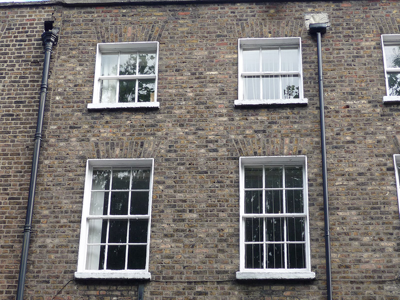Survey Data
Reg No
50100484
Rating
Regional
Categories of Special Interest
Architectural, Artistic
Original Use
House
In Use As
Office
Date
1800 - 1820
Coordinates
316637, 233293
Date Recorded
01/07/2016
Date Updated
--/--/--
Description
Attached three-bay four-storey former house over basement, built c. 1810, having bow to western two bays of rear. Now in office use. M-profile pitched slate roof, behind brick parapet with concrete coping and parapet gutters, with dormer window to south slope of rear pitch. Shouldered rendered chimneystacks with terracotta pots to east end; cast-iron and replacement uPVC downpipes. Flemish bond brown brick walling on painted masonry plinth over painted rendered basement walling; rendered to rear. Square-headed window openings, diminishing to upper floors, with painted rendered reveals and painted granite sills. Timber sliding sash windows, front elevation having three-over-three pane with angled horns to top floor, six-over-six pane without horns to second floor and one-over-one pane with ogee horns to lower floors; rear elevation has three-over-three pane to top floor and six-over-six pane to lower floors. Bowed metal balconettes to first floor and steel grille to one basement opening. Round-headed doorcase, having cavetto-moulded architrave with ribboned festoons and garland, Adamesque Ionic columns, fluted frieze with rosettes and cornice, plain fanlight in moulded architrave and six-panel timber door with brass furniture. Hall has decorative ceiling rose and segmental archway with moulded archivolt on moulded corbels. Recent paved platform bridging basement, with two matching steps to street level. Basement enclosed by wrought-iron railings with decorative cast-iron posts on painted moulded granite plinth with decorative cast-iron corner posts. Matching entrance gate and recent steel steps to basement, recent replacement door to one basement opening. Rear of plot has carparking and steel roller gate in concrete block boundary wall to Little Fitzwilliam Place.
Appraisal
A late Georgian former house, likely built as a pair with No. 35 and converted to offices. The building retains the well-balanced proportions and graded fenestration pattern typical of the period and is enriched with a pretty doorcase featuring garlands and ribbons, Ionic columns and a decorative entablature. With its intact setting details, No. 36 makes a strong contribution to the historic and largely cohesive character of Baggot Street, which has been fairly well retained along this northeast stretch. Development of Baggot Street began at the west end in the late eighteenth century, but was slow due to the recession at that time; however by the mid-nineteenth century the street had developed into a thriving residential thoroughfare. Due to this staggered development there are many signs of speculative building, including variation in levels, materials and detailing.















